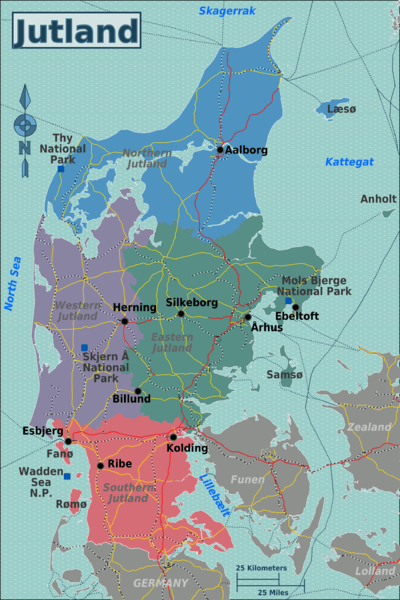Jutland
Jutland (Danish: Jylland) is the mainland part of Denmark. It is a large peninsula connected to the European continent and stretching northwards towards the Scandinavian Peninsula. It's about 350 km long from the border with Germany to its northern tip, although the northernmost part is actually an island. It makes up nearly 70% of Denmark's land area and is home to 2.5 million people, roughly half the country's population. Jutland's largest city is Aarhus; the country's capital and largest city, Copenhagen, is not on Jutland, but on the island of Zealand.
While the North Jutlandic Island (Nørrejyske Ø or Vendsyssel-Thy) is an island, is it usually referred to as part of North Jutland.
Regions
Cities
- 🌍 Aalborg - A regional centre for the northern part of the peninsula, with an attractive old town in the city core.
- 🌍 Aarhus - Jutland's unofficial capital, and most populous city. Home of some of the regions best attractions.
- 🌍 Billund - Home of Lego, and the original Legoland Park, of Denmark's top attractions, and the regions major airport.
- 🌍 Ebeltoft - Old charming city centre, the world's biggest intact wooden ship, and beautiful nature.
- 🌍 Esbjerg - Centre of the Danish fishery and offshore industries, and a well-connected access point to the west coast.
- 🌍 Herning - Main city, and a major traffic junction, for Western Jutland.
- 🌍 Kolding - Dynamic city forming one of the corners of one of Denmark's most dynamic commercial regions.
- 🌍 Ribe - Denmark's oldest city, with pretty medieval buildings and cobblestoned streets.
- 🌍 Silkeborg - Main city of the lake lands, one of Denmark's most beautiful regions.
Other destinations
Understand
This article is only dealing with the Danish parts of Jutland, but geographical and geologically speaking, this large peninsula also includes the Schleswig-Holstein region of Northern Germany as well.
Talk
The local language is Danish, which in some parts of Jutland is spoken with a distinct dialect.
While English speakers are perhaps less prevalent than in Copenhagen, most people under 60 will still have at least some understanding of the language. German language proficiency is far better in South Jutland and the West coast than anywhere else in Denmark. In those regions almost everyone will have a basic understanding of German due to the overwhelming number of German tourists descending on the beaches in the summer months. There is also a small indigenous German-speaking minority along the border. Everyone is bi-lingual.
Get in
By plane
Billund Airport is the main airport on the peninsula, and number two in Denmark as a whole - fields many international flights, and has direct connections with almost every major North European hub. Aalborg and Aarhus airports also sees' substantial traffic, with a few international routes on the schedule. There are also several smaller regional airports dotted around Jutland with a couple of daily flights to Copenhagen.
By car
There is two ways to get into Jutland by car.
By boat
There are several ferry lines from southern Norway and Sweden to the northern half of Jutland. From across the North Sea and further west, Esbjerg has a ferry connection to Britain and the weekly ferry from Iceland and the Faroe Islands to mainland Europe arrive at Hirtshals. Domestically, from Zealand and Lolland, there are a couple of direct ferry "shortcuts" if you do not want to travel overland via Funen.
Get around
For intercity transportation in Jutland, there is a network of express buses dubbed XBus, which connects most major towns and cities on routes without or with little rail service. Prices are set according to distance, as a rule of thumb (while in no way completely accurate) expect to pay around 1 kr per kilometre.
See
- Carved runestones. These massive stones from the 10th century in Jelling is a world heritage site.
Do
- Beaches in Blokhus. These beautiful wide sandy beach is one of the west coast's largest tourist draws.
- Fårup Sommerland in North Jutland.
